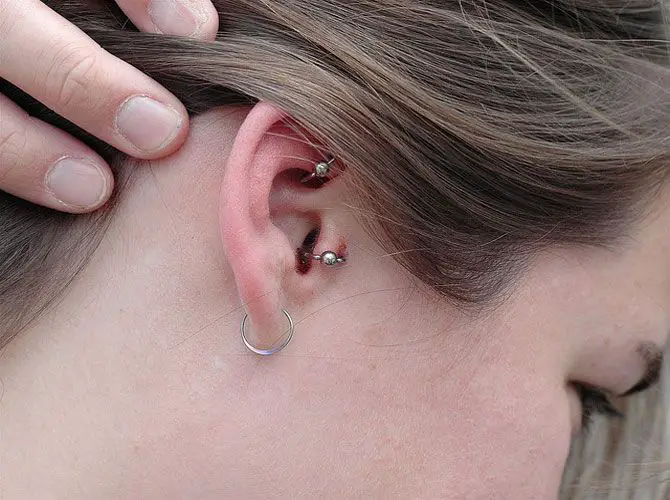You may be surprised to learn that about 30% of all ear piercings become infected even with meticulous care. Some studies put the figure at 35%.
People who get multiple ear piercings are more likely to be affected. High piercings through the cartilage or pinna are especially risky. Piercings in these areas are associated with poor healing and more severe infections due to the auricular cartilage’s avascular nature.
The good news is that most infections are easily treatable. Although some infections may require a visit to the doctor’s office, about 77% are mild and treatable from home. Let’s find out how to spot an infected ear piercing, treatment options, and when to see a doctor.
What’s an Infected Ear Piercing?
An infected ear piercing is an ear piercing that fails to heal the right way. Typically, a new ear piercing takes six to eight weeks to heal. Higher piercings may take up to 12 weeks. Whichever the case, the healing usually progresses without any alarms or excessive pain. The wound should have healed entirely within the stipulated period.
If the wound exhibits unusual signs such as excessive redness, swelling, warmth, itchiness, or tenderness, it’s likely to be infected. The same applies if the piercing is taking longer than usual to heal.
The most common cause is a bacterial infection. If bacteria find a way into the fresh wound, it can result in an infection. Getting pierced in an unhygienic environment is the leading cause of bacterial infections, followed by unsterilized equipment. Touching the wound with dirty hands also increases the risk of infection.
Signs and Symptoms
Signs and symptoms of ear piercing infection vary from one patient to the next. However, most people report;
- Swelling
- Redness
- Pain
- Tenderness
- Itching
- Burning
- Yellow discharge
Treating an Infected Ear Piercing
As mentioned earlier, some ear-piercing infections require that you see the doctor. However, for mild infections, you can treat the infection wound yourself with ease. Indeed, several DIY treatments are now available that you can explore, such as dandruff shampoo.
The zinc pyrithione in dandruff shampoo is an excellent antibacterial that can aid the healing process of infected ear piercings. It can also prevent infection.
However, the primary way to treat infected ear piercings involves using saline water to gently clean the infected area and an over-the-counter antibiotic cream to kill the bacteria. Proceed as follows;
- Wash your hands with soap and water as you don’t want to infect the wound further. It’s best to use running water.
- Prepare a saltwater solution. You’ll need one cup (about 0.24 liters) of water and about ½ teaspoon of salt. Stir the solution until all the salt dissolves.
- With the earring in place, soak a cotton ball in the solution and place it on the affected area, and let it rest for a few seconds.
- Remove the cotton ball and dry the area using a clean gauze or tissue. You can also use another cotton ball.
- Now you can apply the over-the-counter antibiotic cream. Most experts recommend Neosporin or Bacitracin. However, other antibiotic creams work just as well. Make sure to follow the directions on the product label.
Repeat the procedure above three times a day until the infection improves. Additionally, take extra steps to make sure that your hands are clean at all times. Touching the infected area with dirty hands can worsen the issue.
It also helps to change your pillowcase with a clean one at least every two days. Avoid alcohol and hydrogen peroxide, as these can potentially irritate the area.
Further Treatment Tips
If your issue seems more like an allergic reaction rather than a full-blown bacterial infection, then you may need to remove the earrings and clean the area twice a day with a gentle cleanser. Over-the-counter hydrocortisone cream also works excellently for allergic reactions, as do healing ointments such as Cicalfate and Aquaphor.
You’re also advised to remove the earring if you notice that the area is oozing. Additionally, place a towel on your pillowcase and change it daily. The good news is that the oozing should subside in a couple of days. Once it subsides, apply antibacterial cream to the earring post before inserting the earring.
When to See the Doctor
Minor ear piercing infections can progress to perichondritis, abscess formation, and necrosis with or without systemic symptoms. Perichondritis is inflammation of the perichondrium, a layer of tissue surrounding the cartilage of the external part of the ear known as the pinna. Meanwhile, necrosis is a form of irreversible cell injury that results in the death of cells in the affected area.
For the above reasons, you should see the doctor promptly if home remedies down work. Most experts recommend seeing the doctor if the symptoms don’t subside after a week of home treatment.

